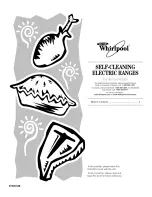
6
Cabinet Dimensions
Cabinet opening dimensions shown are for 25" (64.0 cm)
countertop depth, 24" (61.0 cm) base cabinet depth, and
36" (91.4 cm) countertop height.
IMPORTANT:
If installing a range hood or microwave hood
combination above the range, follow the range hood or
microwave hood combination installation instructions for
dimensional clearances above the cooktop surface.
Range may be installed next to combustible walls with zero
clearance.
NOTE:
24" (61.0 cm) minimum when bottom of wood or
metal cabinet is shielded by not less than 1/4" (0.64 cm)
flame-retardant millboard covered with not less than No. 28
MSG sheet steel, 0.015" (0.4 mm) stainless steel, 0.024"
(0.6 mm) aluminum or 0.020" (0.5 mm) copper.
30" (76.2 cm) minimum clearance between the top of the
cooking platform and the bottom of an uncovered wood
or metal cabinet.
Venting Requirements
IMPORTANT:
This range must be exhausted outdoors unless
you are using ductless venting. See the “Venting Methods”
section.
■
Do not terminate the vent system in an attic or other
enclosed area.
■
Use an approved vent cap for proper performance. If an
alternate wall or roof cap is used, be certain the cap size is
not reduced and that it has a backdraft damper.
■
Vent system must terminate to the outside unless you are
using a ductless vent kit.
■
Use a 5" (12.7 cm) or 6" (15.2 cm) round metal vent or a
3
1
/
4
" x 10" (8.3 cm x 25.4 cm) rectangular vent.
■
Rigid metal vent is recommended. For best performance, do
not use plastic or metal foil vent.
■
If a joist or stud must be cut, then a supporting frame must
be constructed.
■
The size of the vent should be uniform.
■
The vent system must have a damper.
■
Seal all joints in the vent system.
■
Use caulking to seal exterior wall or roof opening around
the cap.
■
Determine which venting method is best for your
application.
For Best Performance:
■
Use 26-gauge minimum galvanized or 25-gauge minimum
aluminum metal vent. Poor quality pipe fittings can reduce
airflow. For external venting, flexible metal vent is not
recommended.
NOTES:
■
For external venting, flexible metal vent is not
recommended. Flexible vent creates back pressure and
air turbulence that greatly reduce performance.
■
Local codes may require a heavier gauge material.
■
Metal duct may be reduced to 30-gauge galvanized steel
or 26-gauge aluminized steel if allowed by local codes.
This reduction is based on information in the International
Residential Codes Section M1601.1 (2006 edition).
■
Avoid installing 2 elbows together.
■
Use no more than three 90° elbows.
■
Make sure there is a minimum of 18" (45.7 cm) of straight
vent between the elbows if more than one elbow is used.
Elbows too close together can cause excess turbulence that
reduces airflow.
■
Do not use a 5" (12.7 cm) elbow in a 6" (15.2 cm) or
3
1
/
4
" x 10" (8.3 cm x 25.4 cm) system.
■
Do not reduce to a 5" (12.7 cm) system after using a
6" (15.2 cm) or 3
1
/
4
" x 10" (8.3 cm x 25.4 cm) fittings.
■
Avoid forming handmade crimps. Handmade crimps may
restrict airflow.
L
A
B
C
D
E
F
M
H
I
J
K
G
J
A. 18" (45.7 cm) upper side cabinet to countertop
B. 13" (33 cm) max. upper cabinet depth
C. 30" (76.2 cm) min. opening width
D. For minimum clearance to top of cooktop, see NOTE.
E. 30" (76.2 cm) min. opening width
F. 3" (7.6 cm) min. clearance from both sides of range to side wall
or other combustible material
G. The shaded area is recommended for installation of rigid gas pipe
and grounded outlet.
H. 20
3
/
8
" (51.8 cm)
I. 7
11
/
16
" (19.5 cm)
J. 4
13
/
16
" (12.2 cm)
K. 3
11
/
16
" (9.4 cm)
L. Cabinet door or hinges should not extend into the cutout.
Содержание W11024189A
Страница 83: ...83 REMARQUES ...
Страница 84: ...02 17 W11024189A 2017 Sears Brands LLC ...







































